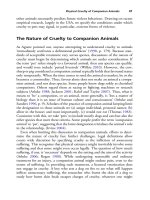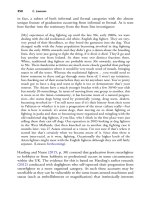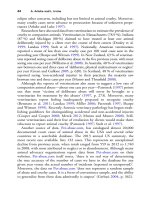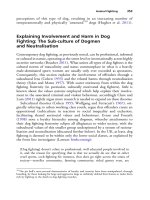The palgrave international handbook of a 170
Bạn đang xem bản rút gọn của tài liệu. Xem và tải ngay bản đầy đủ của tài liệu tại đây (27.35 KB, 1 trang )
162
E. Cudworth
development of an internationalised food system, which co-existed with the
localised model in European regions outlined above. Extensive cattle ranching and sheep grazing was the farming system introduced by European
colonisation of the Americas, Australasia and Africa from the sixteenth to
the nineteenth centuries. This system involved particular forms of exploitative social relations such as the use of slave labour, displaced indigenous
peoples and unwanted or exploited rural peasantries (Franklin 1999,
pp. 128–129; also Nibert 2013). As colonised territories became increasingly
independent, and many drew in burgeoning immigrant populations, the
ranching system—exploitative of both land and labour became the model
for an independent national system of production. In the seventeenth
century, the Spanish and Portuguese imported their native cattle into
South and Central America (Velten 2007). This model was adopted in
much of the Southern USA from the late eighteenth to late nineteenth
century, as ranchers were seeking to increase profits by serving the expanding
markets in Europe.
Throughout the first half of the nineteenth century, the breeding methods
pioneered in Britain were adopted elsewhere (Ritvo 1990). Animals were
bred to gargantuan sizes, and fat-rich beef was a quintessential sign of status.
This demand and the profits to be made from serving it, resulted in the
‘cattelisation’ of countries such as Argentina and Brazil, and the replacement
of species type in the USA. The ‘Great Bovine Switch’ saw the replacement
of buffalo with cattle through sponsoring the hunting of buffalo which led to
their virtual and almost instantaneous elimination from the Western range
lands after thousands of years of successful habitation (Nibert 2013,
pp. 103–107; Rifkin 1994, pp. 74–76).
The colonial model of meat production was further enabled by the development of refrigerated shipping which made it possible to ship meat to Europe
from the USA, South America and Australasia (Franklin 1999). In order to
make best use of the potential market, the price had to be minimised by
intensifying production and saving labour costs through increased mechanisation. By the 1920s, the USA was leading the way, and millions of diversified
small family farms had been replaced by specialist, large, corporate enterprises
(Nibert 2002). From the 1950s, one of the most important technological
developments was the confinement of chickens for both eggs and meat. Such
farming maximises land use through intensive housing and minimises labour
time as animals are in situ and fed automatically. In the USA, one person
may manage up to 150,000 laying hens (Mason and Finelli 2006), and the
time taken to fatten a bird to slaughter weight declined from 60 to 39 days
between 1966 and 1991, while the amount of feed needed fell from 9 lb to









